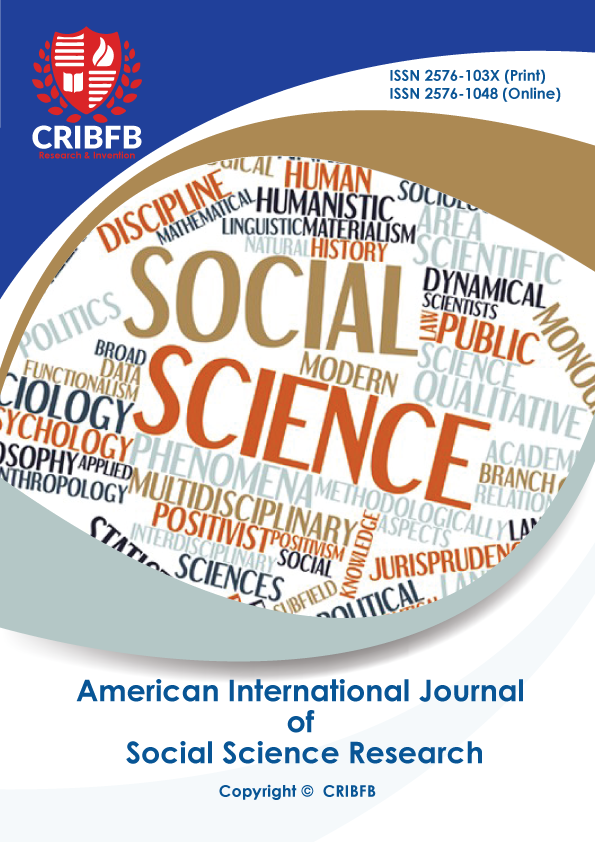USA INVASION IN AFGHANISTAN AND ITS IMPACT ON CENTRAL ASIA
Main Article Content
Abstract
This study Examines the effects of the warfare in Afghanistan, which has resulted in immense casualties, change of political power. The political aspects of American presence in Afghanistan and its effects on the Central Asian region are the main subjects of our research. The goal of the study is to comprehend the complex relationship that emerged after 9/11 attacks and the American invasion. We use qualitative and descriptive-analytical techniques to evaluate the effects of American presence on the Central Asian nations. Our analysis focuses on assessing the effects on the economy, security, and sovereignty of the region. Afghanistan's crucial role in determining the geopolitical dynamics of the area has an impact on Central Asia, which has historically served as a crossroads for world powers. Our finding address important issues pertaining to the strategic goals of the United States in Central Asia. We shed light on how they affect regional sovereignty, economy, and security. The dynamics of Afghanistan have continued to influence interactions and conflicts in Central Asia, magnifying the engagement of international and regional forces as well as the activity of fundamentalist groups. The stability of Central Asian nations is being put under further stress by the growth of extremism. In conclusion, our research reveals the complex interactions between American participation in Afghanistan and the stability and growth of Central Asia. We provide a comprehensive analysis of how the U.S. presence has impacted Central Asian dynamics, illuminating its wider security implications for the region and the world.
JEL Classification Codes: N40.
Downloads
Article Details
Issue
Section
How to Cite
References
Aljazeera. (2022). US watchdog blames Washington, Ghani for the fall of Kabul. Retrieved from https://www.aljazeera.com/news/2022/11/17/us-auditor-washington-ghani-to-blame-for-afghanistans-fall
ANI Asia (2022) US persuades Tajikistan, Uzbekistan governments to allow military bases. Retrieved from https://www.business-standard.com/article/international/us-persuades-tajikistan-uzbekistan-governments-to-allow- military-bases-122011200096_1.html
Angerer, D. (2023). September 11 attacks. History.com. Retrieved from https://www.history.com/topics/21st-century/9-11-attacks
Allaf, M. (2022) THE US’ RARE OPPORTUNITY IN CENTRAL ASIA. Retrieved from https://inkstickmedia.com/the-us-rare-opportunity-in-central-asia
Blank, S. (2008). The strategic importance of Central Asia: an American view. The US Army War College Quarterly: Parameters, 38(1), 1. Retrieved from https://apps.dtic.mil/sti/pdfs/ADA485885.pdf
Center for Preventive Action (2022) Instability in Afghanistan. Retrieved from https://www.cfr.org/global-conflict-tracker/conflict/war-afghanistan Access: 2023, June, 18, 10:27
Congressional Research Service. (2021). Central Asia: Background and U.S. Relations. Retrieved from https://sgp.fas.org/crs/row/R46924.pdf
Dar, S. S. (2014). Strategic Significance of central aSia in 21St century. The Journal of Central Asian Studies, 21(1), 59.
Retrieved from http://ccas.uok.edu.in/Files/93269b6c-7f53-4439-ae9a-3bdf55a4c649/Journal/d746cf43-0d55-4f58-a74e- 5f5a08fc7082.pdf
Dunn, J. (2009). Rethinking American Strategy in Central Asia. Military Academy West Point Ny. Retrieved from https://www.usafa.edu/app/uploads/06_RETHINKING-US-STRATEGY-IN-CENTRAL-ASIA.pdf
Gillard, D. (2023). The Struggle for Asia 1828–1914: A Study in British and Russian Imperialism (Vol. 44). Taylor & Francis.
Gossman, P. (2021). How US-Funded Abuses Led to Failure in Afghanistan. Just Security. Retrieved from https://www.hrw.org/news/2021/07/06/how-us-funded-abuses-led-failure-afghanistan
Iwm. (2023). Afghanistan War: How did 9/11 lead to a 20-year war? Retrieved from https://www.iwm.org.uk/history/afghanistan-war-how-did-911-lead-to-a-20-year-war
Imamova, N. (2022a) Experts Urge US to Update Its Central Asia Strategy. Retrieved from https://www.voanews.com/a/6424466.html
Imamova, N. (2022b) What America's ‘Message Diplomat’ Told Central Asia. Retrieved from https://www.voanews.com/a/what-america-s-message-diplomat-told-central-asia/6817276.html
Karin, E. (2004). The Shanghai Cooperation Organization and Its Implications for Central Asia. Slavic Eurasian Studies, 2. Retrieved from https://src-h.slav.hokudai.ac.jp/coe21/publish/no2_ses/4-3_Erlan.pdf
Krzysztof, S. (2002). “Russian Policy in the Caucasus and Central Asia”, in Bugajski, Janusz ed., Toward an Understanding of Russia; New European Perspectives (New York, the Council on Foreign Relations, 119)
Luong, P. J., & Weinthal, E. (2002). New friends, new fears in Central Asia. Foreign Affairs, 81(2), 61-70.
McClellan, S. A. (2013). The Shanghai Cooperation Organization: Should the US be Concerned?. US Army War College. Retrieved from https://apps.dtic.mil/sti/pdfs/ADA589436.pdf
Maynes, C. W. (2003). America Discovers Central Asia. Foreign Affairs, 120-132. https://doi.org/10.2307/20033508
Mihalka, M. (2008). “Pashtunistan, NATO and the Global War on Terror: “If you do not fight, you cannot have peace in Afghanistan,” The China and Eurasia Forum Quarterly, 6(1), 72-72.
NATO. (2022). NATO and Afghanistan. Retrieved from https://www.nato.int/cps/en/natohq/topics_8189
Olcott, M. B. (2000). Democracy in the Central Asian Republics.Retrieved from: https://carnegieendowment.org/2000/04/01/democracy-in-central-asian-republics-pub-400
Putz, C. (2018) Central Asia’s Democratic Backslide Continues, Except for Uzbekistan, Retrieved from https://thediplomat.com/2018/04/central-asias-democratic-backslide-continues-except-for-uzbekistan
Prakash, S. (2003). US involvement in Afghanistan: Implications for the future. Journal of Peace Studies, 10(1).
New Delhi, p.23.
Rumer, E., Sokolsky, R., & Stronski, P. (2016). US policy toward Central Asia 3.0 (Vol. 25). Washington, DC: Carnegie Endowment for International Peace.
Risen, J. (2021) A WAR’S EPITAPH For Two Decades, Americans Told One Lie After Another About What They Were Doing in Afghanistan. Retrieved from https://theintercept.com/2021/08/26/afghanistan-america-failures
Sullivan, C. (2019). The superpower and the “Stans”: Why Central Asia is Not “Central” to the United States. SAIS Review of International Affairs, 27. Retrieved from https://saisreview.sais.jhu.edu/the-superpower-and-the-stans-why-central-asia-is-not-central-to-the-united-states
Smith, J. M. (2009). The great game, round three. The Journal of International Security Affairs, No17, fall. Retrieved from http://www.securityaffairs.org/issues/2009/17/smith.php
Umarov, T. (2021). Is There a Place for a US Military Base in Central Asia?. Carnegie Moscow Center. Retrieved from https://carnegiemoscow.org/commentary/84685
Whitlock, C. (2019) BUILT TO FAIL, The Washington post. Retrieved from https://www.washingtonpost.com/graphics/2019/investigations/afghanistan-papers/afghanistan-war-nation- building




